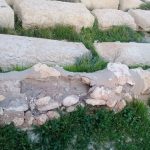Homs, SANA-Palmyra has always been conceived as an oasis that emerged in the middle of the Syrian desert, but there have been many questions on how this city was living in the heart of unfertile desert.
The ancient Palmyrenes made intensive networks of reservoirs and channels to capture and store rainfalls from sudden seasonal storms and to channel water from outside the city to the houses, temples, churches and bathhouses.
They also constructed clay-made canals and stone-made pipelines which were used for transporting sewage according to a developed artistic system.
The landscape around the city, it now appears, was intensively planted with various types of trees as the ancient Palmyrenes used modern irrigation methods.
The Palmyrenes also built a drinking water network, Khalil al-Hariri, Secretary of Palmyra Museum told SANA reporter, adding that Palmyra was rich in springs which were used for supplying the city with drinking water.
The Palmyrenes used canals to transport water from Abu al-Fawares area, 5 km away from the city, as water canals extend over the archeological road which leads to al-Qobour “Tombs” valley.
Al-Hariri added that when water passes through low areas, the canals were lift on a stone wall to facilitate the movement of water in order to reach Palmyra City where it is distributed through an organized engineering network to the required areas.
At Palmyra’s main thoroughfare which is lined with Corinthian columns, one can see two main canals for distributing water, the first of which is made of clay and it is painted with a layer of gypsum and stones dating back to the first Palmyrene phase.
The second channel consists of stone-made parts that are carved in an artistic way and put close to each other to be distributed to the required areas.
Al-Hariri added that there is a main canal used to transport water to the bathhouses of Queen Zenobia which covers an area of 4 thousand square meters.
He indicated that the Palmyrenes were also interested in building underground drainage channels as there are holes between the lined up stones through which one can see stone-made pipelines which were used for drainage.
Ruaa al-Jazaeri
 Syrian Arab News Agency S A N A
Syrian Arab News Agency S A N A




